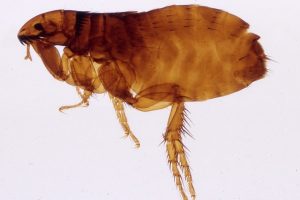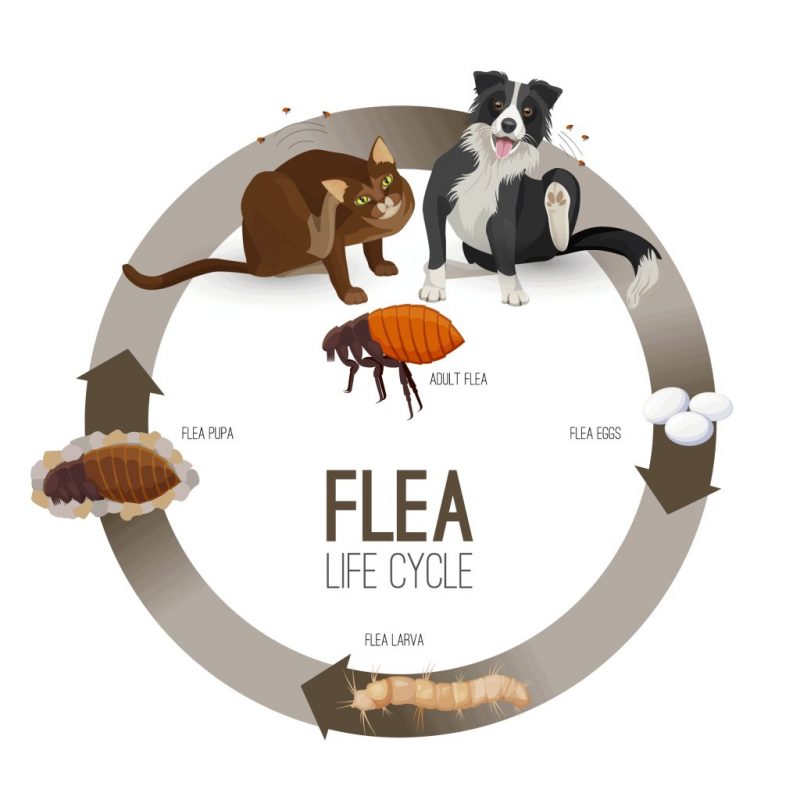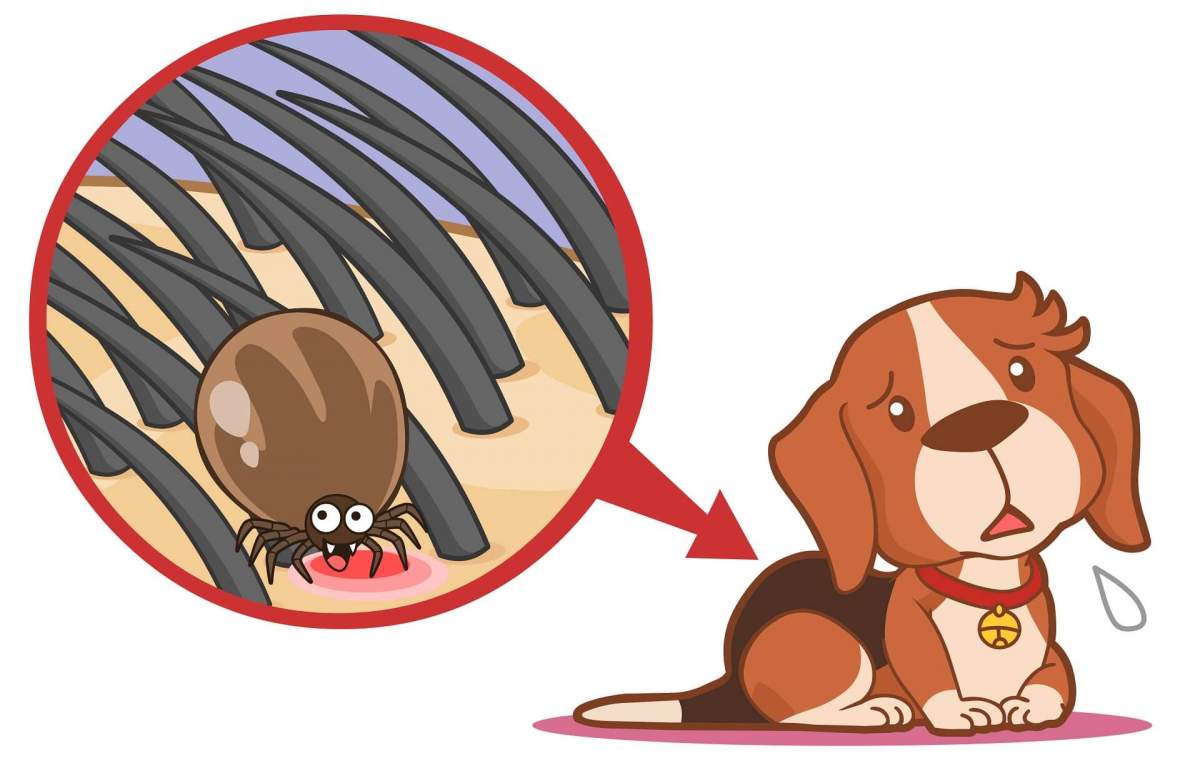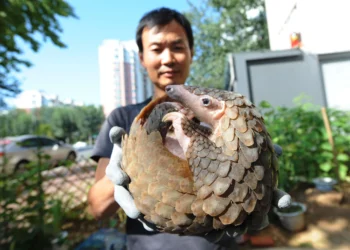Is your dog itchy, scratchy, and restless? You should examine it closely as it exhibits all the typical signs of a flea infestation. The infestation must be taken seriously because dog fleas are difficult to eliminate, in particular, if the environment is contaminated.
Dog Fleas – Appearance and Lifestyle
What do dog fleas look like?

The fleas are about 3mm high, are flattened on the sides, and have powerful legs with which they can jump up to 20cm in height and 60cm in length. However, they usually only do this to reach their host.
We can recognize fleas with the naked eye on a dog. However, depending on the severity of the infestation, it may take some time to detect a flea.
Lifestyle & lifespan
To feed, fleas need one meal a day: they pierce the skin and suck the blood of the host animal.
In theory, they can survive for several months. However, in practice, the average lifespan of a flea is only one to three weeks, because the host animal will kill it during its toilet or by biting itself.

How do I know if my dog has fleas?
A dog infected with fleas will show the following typical symptoms: severe itching, small scabs (especially on the back, stomach, and inner thighs), and possibly hair loss or inflammation of the skin from scratching.
See fleas with the naked eye
It is far from easy to spot adult fleas with the naked eye on the animal’s body. You will only be able to spot them with the naked eye if there is a massive infestation, or if your dog has a short coat. The easiest way is to equip yourself with a flea comb and apply it all over your body, but despite everything, you are very likely not to find anything.
Reading Suggestion: Worms in dogs And Cats: All You Need to Know About Pet Worms
Look for flea droppings
There is a simple trick to tell if your dog has fleas. Look in its coat if you find small black pieces: these are flea droppings! You can run a fine comb through his coat to find them. Rub it on a damp absorbent paper. Since flea poop contains undigested blood, you should see a reddish color in it.
Flea allergy in dogs
Sometimes dogs also develop an allergy to flea saliva, known as flea bite allergy dermatitis (also known as DAPP). In this disease, a single flea bite is enough to cause restlessness, itching and intense scratching. The area around the base of the tail is often affected, which can lead to bleeding and purulent inflammation in this area.
Fleas or dog lice?
Dog lice can also cause itching in our canine friends. So how can we tell them apart? Unlike fleas, lice stick their eggs on the dog’s coat. In addition, the appearance of the two species is very different and a veterinarian can with the naked eye (or under a microscope if necessary) tell you what type of parasite it is. What’s more, he can take a swab of the dog’s fur to see if it finds any lice eggs.
How do fleas reproduce?
From egg-laying to nymph
Fleas breed in the fur of the infected dog. This is where female fleas lay their eggs: 20 eggs on average per day and up to 50 in a single laying. Then they fall to the ground and are distributed in the environment. After a while, the larvae hatch. They will feed on the droppings of adult fleas or organic waste left in the environment. They don’t like light and therefore hide in cracks in the floor, or in the fibers of the carpet or rugs.
After 2 months, the larvae weave a cocoon where the nymph will form.
The wait and the attack of the host
When there are signs that a potential host is nearby (heat, the vibration of footsteps on the ground, carbon dioxide from exhaled air), the “pre-emergent” fleas as they are called at this stage, will hatch and attack the animal in question. Namely that they can stay 6 months on standby if they do not receive the favorable signals from the environment.
A heavy flea infestation can lead to the death of the host animal
During a suction time (two to ten minutes), a flea sucks up to 20 times the capacity of its stomach. Thus a heavy parasite infestation in young or weak animals can lead to anemia, or sometimes even death. Bartonellosis, also known as cat scratch disease, is one of the bacterial diseases. People can also be infected with it.
How to treat fleas in dogs?
Contact insecticides
There are different flea products available to treat your pet. In general, your veterinarian will prescribe a contact insecticide suitable for your companion (age and breed of the dog, lifestyle, possible allergy, etc.). Follow your vet’s recommendation as some insecticides can be dangerous for puppies. The duration of action varies in each case, as does the frequency of treatment. And above all, do not use an anti-flea product for dogs on a cat, without asking your vet for advice: some can be fatal for your hairball.
Development inhibitors
Insecticide products are often combined with development inhibitors, which in turn prevent flea larvae from hatching from the egg, and existing larvae from molting. This is because fleas, whatever their stage of development, must be killed and inhibited at the same time.
So-called flea vaccines are actually development inhibitors. Tablets and some shampoos can also be used.
Follow the prescribed treatment
It is important to follow the treatment prescribed by your veterinarian. At too low a dose, these products are ineffective, while at too high a dose, they are dangerous for the health of your companion.
It is also essential to renew the treatment, because it is rare for it to be effective the first time, especially if the environment is contaminated: your dog can easily recontaminate itself. You have to take your pain patiently, and strictly follow the protocol.
Home treatment & transmission to humans
How to kill dog fleas in the house?
It is important to treat the environment and to clean the house at the same time as the dog. Almost 80% of the flea population consists of eggs and larvae, which must be removed before they turn into adult fleas and infest the dog again. Remember to treat the floor, furniture, cushions, the transport box as well as the back seat of the car! Wash textiles at 60 to 90 ° C or freeze them for 24 hours.
Are dog fleas dangerous for humans?
A flea can bite a human who strokes an infected dog or jump on a human passing nearby if the environment is heavily infested, primarily for food. Its bite causes severe itching. You can get infected by scratching where the bite was (by bacteria getting in). Fleas are also carriers of parasites: for example, children, in particular, can be infected with the tapeworm “Dipylidium caninum” if they swallow an infected flea.

Flea Myths and Beliefs: True from False
There are many myths surrounding dog fleas.
Here is an overview of where we disentangle the true from the false.
1) Fleas are only present when it is hot?
Legend has it that fleas only move in hot weather and jump from dog to dog. It’s wrong! Fleas, of course, prefer temperatures between 25 and 30 degrees, and their reproduction is limited to low outdoor temperatures. But there is no season for these pests, they are present all year round.
2) Without blood, fleas die quickly?
Most fleas stay on their host for up to 100 days in their lifetime. Typically, dogs pick up their fleas from the nearby environment, such as when they go for walks. An adult flea can protected in its cocoon, survive for up to a year without food and wait for a host to approach. Which invalidates the second myth that fleas die quickly without feeding on blood.
3) Fleas only nest in dirty apartments?
According to popular belief, fleas are found only in dirty apartments. But a sparkling apartment will also be quite suitable for their offspring: in the cracks in the floor, in the carpet, between the cushions of the sofas, or in the baskets of the dog and the cat. Vacuuming and cleaning regularly will reduce the number of fleas, but unfortunately will not eliminate them permanently.
4) Aren’t fleas dangerous?
Some say that a flea alone is not of concern. Well, don’t believe them!
Fleas in adulthood are just the tip of the iceberg. Over 90% of fleas are found in the environment as eggs, larvae and nymphs, which are future developing adult fleas.
5) Fleas: in dogs above all?
Fleas are most frequently found not in dogs, but in cats. You must not be fooled by its name! This chip is not specific to its host: it affects dogs, but also cats, rats and humans.
6) Are fleas harmless to humans?
The medical consequences of flea bites for animals, as well as for humans, are generally underestimated. These bites can irritate the skin, transmit bacteria, but also the tapeworm: let us quote for example the Ténia Dipylidium Caninum.
7) do garlic and onion help fight fleas?
Some people claim that you can get rid of fleas with a garlic-based diet or with onion rubs. Unfortunately, it doesn’t really work. And most importantly, garlic and onion are toxic to dogs.
Further Frequently Asked Questions
how to get rid of fleas on dog?
how to get rid of fleas on a dog?
how to get fleas off my dog?
how to tell if your dog has fleas?
how to tell if dog has fleas?
why is my dog so itchy but has no fleas?
how to get rid of dog fleas?
how do i know if my dog has fleas?
how to know if your dog has fleas?
how do you know if your dog has fleas?
what to do if your dog has fleas?
how does a dog get fleas?
how to get rid of dog fleas fast?
how to know if dog has fleas?
how to kill fleas on dog?
how to get fleas off a dog?
what to do if dog has fleas?
how to get fleas off dog?
how do you kill fleas on a dog?
how to get rid of fleas on my dog?
how to remove fleas from dog?
how to tell if my dog has fleas?
what to do about dog fleas?
when karen realized her dog had fleas, karen was faced with?
how to know if my dog has fleas?
how to get rid of fleas off a dog?
what do dog fleas look like?
how to rid dog of fleas?
how to rid your dog of fleas?
how to keep fleas off my dog?
how to tell if a dog has fleas?
what do fleas eggs look like on a dog?
why does my dog nibble on me like i have fleas?
how did my dog get fleas?
what do fleas look like on a dog?
how long does it take to get rid of fleas on a dog?
how to kill fleas on a dog?
how to take fleas off a dog?
how to check dog for fleas?
my dog has fleas what do i do?
how to tell if dog has fleas or just dry skin?
what can i use to kill fleas on my dog?
how do i get rid of fleas on my dog?
how to treat dog fleas?
how to get rid of fleas on your dog?
how can i get rid of fleas on my dog?
what do i do if my dog has fleas?
when karen realized her dog had fleas karen had?
how many fleas on a dog is considered an infestation?
how to check a dog for fleas?









